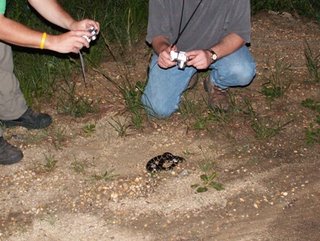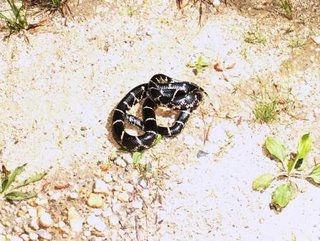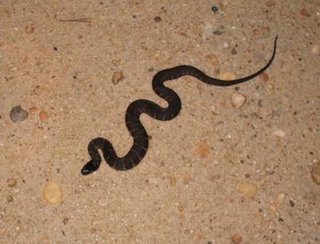Sounds great, right? So why haven’t I gone evening road cruising before? I can think of a couple reasons. The first is that it always struck me as a little nutty. You drive around at slow speeds at night, and then jump out of the car into the road as soon as you spot something in your headlights. A herping acquaintance in Baltimore once explained that the real way to do it is to have someone up on the hood of the car so nothing gets away in the time it would take to open the car door.
The other reason is that it strikes me as a little too technological. I know it’s really time-efficient, and I’m no Luddite, but road cruising seems like a pretty perverse way to experience nature. I feel that we’re maximizing the number of finds to the detriment of the overall experience.
One of the main reasons I go out looking for herps is to access the wonder of the natural world through the objects of my particular obsession: reptiles and amphibians. I love to hike out to immerse myself in their world and observe how they fit into it. I like to get my boots dirty and see the critters in their habitats. A snake crossing blacktop is almost totally isolated. It is not the snake in its environment, it is the snake isolated and horribly vulnerable on an artificial surface, viewed through a windshield.
One of my favorite Pine Barrens finds of all time was a Fowler’s toad (Bufo fowleri) I found in the Pine Barrens sitting next to a small log from which a steady stream of winged termites was emerging. The toad was the most beautiful pale grey with sharp black spots, a pattern that blended in perfectly with the sandy soil, and it was ridiculously fat from all the termites it had already stuffed in its belly. We saw at least 130 Fowlers toads last Wednesday, but they all seemed a little out of place to me. [Here is one toad on the road]


Now that I’ve gotten all of that out of my system, I need to admit (a little guiltily) that I had a blast! Toads are nice and all that, but they’re not kingsnakes. I’d never caught an eastern kingsnake (Lampropeltis g. getula) in the Pine Barrens, and we saw two. True, one had just been killed by another vehicle, but it was still thrilling. [Here is the live kingsnake. One of the best ways to get a picture of a squirmy snake is to hold it down for a few seconds, take your hands away, and snap the photo before it bolts.]



I also had a great time with my fellow road cruisers. I’d only communicated with Bill, Dave, and Frank by email before, but there’s something about sharing such a rare, nerdy passion that breeds instant familiarity. It’s clear right away that you’re among your own kind.
Road cruising also unifies observation in funny ways. When you’re out with other people hiking or flipping cover, you’re each looking at something different – multiple people searching independently. In a car, you’re all staring forward together, and when something herp-like (snake or stick? turtle or rock?) appears at the hazy edge of the headlights’ field of view, you all lean forward and stare together, you all hold your breath together, and you all lean back together once it’s obvious that yep, that’s a stick.
We headed out from Frank’s place in South Jersey and cruised around Burlington County and a little of Atlantic County. We saw those kingsnakes, the hordes of toads (mixed in with a few green frogs – Rana clamitans melanota), and heard a lot of frogs calling off beyond the edge of the road. Maybe next time I’ll come more equipped to charge off into the woods to spotlight the little guys. [Here is one of the green frogs]

We found two northern water snakes (Nerodia s. sipedon) also, again one live one and one recent DOR (dead on road) – its tail was still reflexively twitching even though its head was still and its guts were splattered out on the pavement.
I’m glad we ended with the live water snake. [Here is the live one, on the sand road and then suffering the indignity of being measured]


I know we had nothing to do with killing the two dead snakes, but it breaks my heart to see them dead like that. The kingsnake was the worse of the two – a gravid female with at least six shelled eggs in her, all ready to be laid. One had been shot out her vent by the impact of the tire that killed her, and most of the others had been broken inside her, so what oozed out of her was a yolky, bloody mess. [We pulled the dead female off the road for a closer examination]

I want to end (before the totals) by thanking Bill, Dave and Frank for taking me along. I learned a lot on that trip, both by watching them work (these guys probably have 100+ years of field herping experience between them) and by talking while we were driving. I had a great time, and I look forward to our next trip.
The weather was humid with temps falling from the high 70s into the high 60s
- 130+ Fowler’s toads (5+ heard calling)
- 20+ green frogs
- 2 eastern kingsnakes
- 2 northern water snakes
- 10 carpenter frog (Rana virgatipes) heard calling
- 3 Pine Barrens tree frogs (Hyla andersonii) heard calling
No comments:
Post a Comment